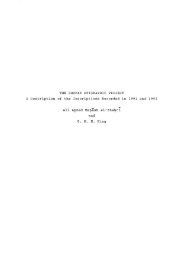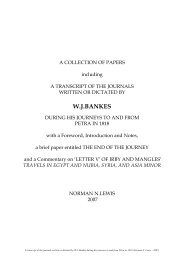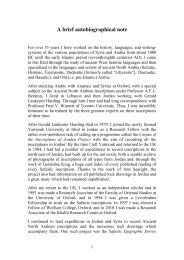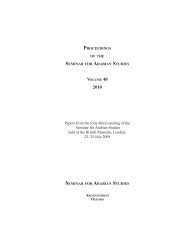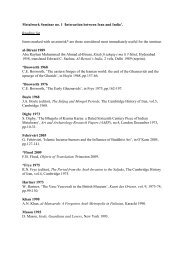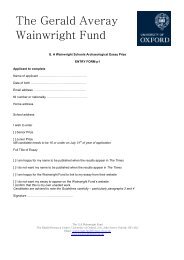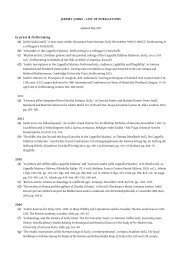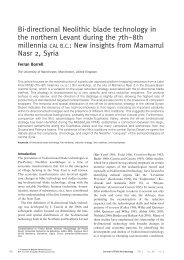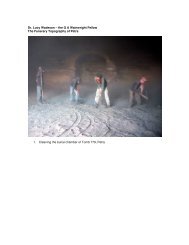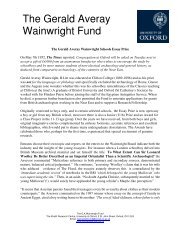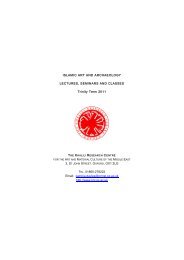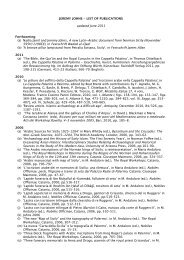W. J. Bankes and the Identification of the Nabataean Script - Khalili ...
W. J. Bankes and the Identification of the Nabataean Script - Khalili ...
W. J. Bankes and the Identification of the Nabataean Script - Khalili ...
You also want an ePaper? Increase the reach of your titles
YUMPU automatically turns print PDFs into web optimized ePapers that Google loves.
62 N.N. LEWIS <strong>and</strong> M.C.A. MACDONALD<br />
Syria 80 (2003)<br />
The collection also contains fair copies <strong>of</strong> four o<strong>the</strong>r <strong>Nabataean</strong> inscriptions from Sinai which were evidently<br />
<strong>the</strong> work <strong>of</strong> Linant, <strong>and</strong> which do not appear on <strong>Bankes</strong>' plate. Three <strong>of</strong> <strong>the</strong>m (nos 14-16 here) are in sepia or<br />
reddish ink on a sheet (see Fig. 7a) with one Greek inscription (see Appendix D, no. 1), one Coptic (see Appendix<br />
E), <strong>and</strong> one Kufic (see Appendix F, n° 1) <strong>and</strong> drawings <strong>of</strong> two camels, one led by a man with a long staff. The<br />
number 9 appears in <strong>the</strong> top left h<strong>and</strong> comer <strong>and</strong> > near <strong>the</strong> bottom, both in Linant's h<strong>and</strong>. 100<br />
The o<strong>the</strong>r sheet (Fig. 7b/IV) bears only one pencil copy <strong>of</strong> a <strong>Nabataean</strong> inscription (n° 17 here), with below<br />
it <strong>the</strong> word < Magara >> in black ink, not in Linant's h<strong>and</strong>. However, it is numbered > in Linant's writing <strong>and</strong><br />
<strong>the</strong> word > [?] in blue-green ink, also in his h<strong>and</strong>, has been written on <strong>the</strong> reverse <strong>of</strong> <strong>the</strong> sheet. That<br />
<strong>the</strong>se refer to <strong>the</strong> Wadi Magharah is confirmed by <strong>the</strong> identification <strong>of</strong> this inscription as CIS II 750 for which<br />
<strong>the</strong> provenance is given as Wadi Qene', a small valley at <strong>the</strong> east end <strong>of</strong> <strong>the</strong> Wadi Magharah. 101 We know that<br />
Linant <strong>and</strong> Ricci passed through this wadi twice on <strong>the</strong>ir travels in Sinai. 102<br />
Linant de Bellefonds <strong>and</strong> <strong>Bankes</strong><br />
<strong>Bankes</strong> first became acquainted with Louis Linant de Bellefonds <strong>and</strong> ano<strong>the</strong>r young man, Aless<strong>and</strong>ro Ricci,<br />
in 1818 <strong>and</strong> added <strong>the</strong>m to his to search for <strong>and</strong>, if possible, reach <strong>the</strong> ruins <strong>of</strong><br />
Meroe. 104 Linant <strong>and</strong> Ricci went toge<strong>the</strong>r to Siwah at <strong>the</strong> beginning <strong>of</strong> March 1820 <strong>and</strong> returned to Cairo at <strong>the</strong><br />
end <strong>of</strong> <strong>the</strong> month. After <strong>the</strong>ir return, instead <strong>of</strong> making immediate preparations for <strong>the</strong> expedition to Nubia, as<br />
he had undertaken to do, Linant remained for a time in Cairo <strong>and</strong> <strong>the</strong>n on 1 st September left for Sinai, again with<br />
Ricci.<br />
They were away for over two months, visiting a number <strong>of</strong> ancient sites including <strong>the</strong> Pharaonic mining towns<br />
at Wadi Magharah <strong>and</strong> Serabit al-Khadim, <strong>and</strong> eventually reaching <strong>the</strong> sou<strong>the</strong>rnmost tip <strong>of</strong> <strong>the</strong> peninsula at Ra's<br />
Muhammad. They twice passed through Tur, near Jabal Naqus, <strong>and</strong> probably traversed Wadi Hebran. Both <strong>of</strong><br />
<strong>the</strong>m 105 produced drawings <strong>and</strong> water-colours which were eventually sent to <strong>Bankes</strong> in Engl<strong>and</strong> <strong>and</strong> are still in<br />
<strong>the</strong> collection.<br />
<strong>Bankes</strong> had not authorised <strong>the</strong> journey to Sinai <strong>and</strong> was angry with Linant for undertaking it <strong>and</strong> <strong>the</strong>reby<br />
delaying <strong>the</strong> expedition to Meroe. 106 Never<strong>the</strong>less, after a prolonged argument by correspondence, Linant<br />
prevailed on <strong>Bankes</strong> to pay for it <strong>and</strong> much else besides, <strong>and</strong> in 1823 travelled to Engl<strong>and</strong> as <strong>Bankes</strong>' guest,<br />
taking with him <strong>the</strong> better eter part r <strong>of</strong> <strong>the</strong> he harvest <strong>of</strong> his travels, that is to say his drawings, maps, plans <strong>and</strong><br />
observations. They are in very considerable numbers <strong>and</strong> such <strong>of</strong> <strong>the</strong>m as are finished are very delicate <strong>and</strong><br />
beautiful, >> as <strong>Bankes</strong> wrote to his fa<strong>the</strong>r. 107 Having paid Linant to do <strong>the</strong> work, <strong>Bankes</strong> regarded <strong>the</strong> ><br />
as his own property. He had lithographic plates prepared <strong>of</strong> some <strong>of</strong> <strong>the</strong> Siwah water-colours <strong>and</strong>, as we have<br />
seen, included six <strong>of</strong> Linant's copies <strong>of</strong> <strong>Nabataean</strong> inscriptions in Sinai on <strong>the</strong> plate along with his own.<br />
100. For <strong>the</strong> present locations <strong>and</strong> reference numbers <strong>of</strong> this sheet <strong>and</strong> <strong>the</strong> next see <strong>the</strong> captions to Figs 7a <strong>and</strong> 7b/(iv).<br />
101. CISII.1, p.387.<br />
102. See MAZUEL 1937: 17-18 for <strong>the</strong>ir itineraries in Sinai.<br />
103. FINATI 1830,11:301. Finati had served as a soldier in Muhammad 'All Pasha's army in Arabia. <strong>Bankes</strong> engaged him on September<br />
16th 1815, as servant, interpreter <strong>and</strong> guard, or > as Finati liked to call himself. He accompanied <strong>Bankes</strong> on <strong>the</strong> Nile journey<br />
<strong>of</strong> 1815 <strong>and</strong> <strong>the</strong> Syrian journeys <strong>of</strong> 1816. He returned to Egypt when <strong>Bankes</strong> went to Asia Minor in June 1816, <strong>and</strong> rejoined him in<br />
Jerusalem, at <strong>Bankes</strong>' request, for <strong>the</strong> Petra expedition in 1818. He was generally known as . When he was in Engl<strong>and</strong><br />
in 1826 <strong>and</strong> was asked, in a court <strong>of</strong> law, if he were a < Mahometan >, he is reported to have replied < I attend <strong>the</strong> mosque in Turkey,<br />
but I am a Christian here. >> (ANON [BUCKINGHAM ?] 1826: 65).<br />
104. FINATI 1830, II: 344.<br />
105. MAZUEL 1937: 17-18; SAMMARCO 1930: 90-100, 153.<br />
106. Letters: Salt to <strong>Bankes</strong>, 10-10-1821,6-1-1822,7-2-1823, <strong>and</strong> 18-2-1823; <strong>Bankes</strong> to Salt 29-9-1823 (D/BKL HJI/159,169,196,<br />
201, <strong>and</strong> 227 respectively).<br />
107. Letter: W.J. <strong>Bankes</strong> to Henry <strong>Bankes</strong>, 23-11-1823 (D/BKL, no reference number).



